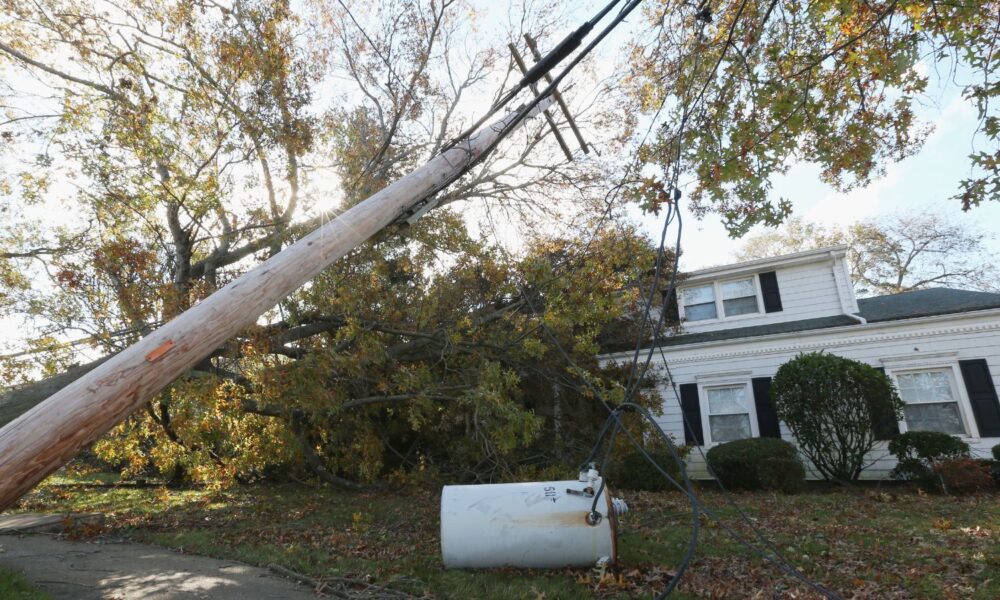When Hurricane Beryl hit Texas this past July, millions of customers lost their power, some for over a week. This event, though saddening, is not a unique one. In recent years the frequency of extreme weather events has skyrocketed, and many events have included power outages that threaten people’s safety and even lives.
Extreme weather, which is increasing due to climate change, can degrade the electricity system and cause these failures. In fact, between 2000 and 2023, 80% of all major power outages in the United States were due to weather, including severe storms, wildfires, and extreme heat. Power outages are costly, can have extreme impacts on both the health and safety of a population, and can happen at any point in the process of electricity generation, distribution, and usage.
The traditional electricity grid starts with generation of electricity from power plants fueled by gas, nuclear, coal, or, increasingly, renewable energy sources like solar and wind. After this, the electricity passes through high-voltage transmission lines that bring the power closer to those who use it and through substations that reduce the voltage. Finally, the electricity runs through distribution lines and transformers, which bring power to customers in homes and businesses. These distribution lines are thinner and often strung on the wooden poles you may see where you live.
At the other end of electricity’s journey, in customer’s homes and businesses, extreme weather can increase energy usage; for example, high temperatures create a need for air conditioning, which leads to high demand on the grid that threatens an insufficient supply.
Fortunately, there are solutions to some of these extreme weather impacts on the electricity system.
Before we consider solutions, let’s look at how the distribution system, the part of the grid between transmission and customer use and the most common failure point in power outages, is affected by extreme weather.
How does extreme weather affect distribution grids?
Climate change is increasing weather extremes and decreasing its predictability. While it may seem that a place such as Texas only needs to plan for increasing temperatures, events like Winter Storm Uri in 2021 proved the opposite. Below are five types of impacts on the distribution grid from increased extreme weather due to climate change.
- Hurricanes/High Winds: Hurricanes and high winds damage distribution wires either directly or via falling vegetation, causing poles to snap or fall, and bringing down lines.
- Heat: High temperatures can shorten the life and decrease the capacity of transformers. They can also reduce the efficiency and capacity of power lines; at 100 degrees, for example, there is a reduction in distribution line capacity by 7-8%. High heat, a combined effect of both ambient temperature and increased current on the lines due to increased demand for air conditioning, can also cause lines to sag excessively and contact vegetation, leading to short circuits and blackouts.
- Flooding/Sea Level Rise/Storm Surge: Water can physically damage and corrode infrastructure, particularly distribution poles and substations.
- Wildfires: Fires can damage lines and poles, decreasing capacity of the lines or shutting them down. Soot can accumulate on the insulators and create a “conductive path,” causing lines to power off due to danger of short circuits. Some electric utilities pre-emptively shut down distribution (and transmission) lines during times of high wildfire risk to avoid the possibility of sparking more fires.
- Winter/Ice Storms: When ice accumulates on wires, they sag and break or become more vulnerable to wind. Ice storms can also bring trees down on power lines.
Though it is very costly, if not impossible, to prevent all outages due to weather, there are many ways that the distribution grid can become more resilient as extreme weather becomes more common.
Outage prevention can happen at the component level
One set of solutions for grid resilience is power outage prevention at a component level. This means grid “hardening” or increasing the durability of the poles and wires to lessen the impact of extreme weather on infrastructure.
Grid hardening can involve structural reinforcement of the infrastructure. Switching distribution poles from wood to steel or steel-reinforced cement can decrease the chance of a pole snapping or catching fire. Using extra insulation on the lines provides protection from contact with objects (such as vegetation and birds) that can degrade the equipment as well as increase the risk of electrical faults and sparks that cause wildfires.
Redundancy, or ensuring that the system does not rely on a single component, is already practiced in transmission, but would benefit the distribution system to keep the lights on in the event of a downed line. This way, if one line fails the power can be rerouted through other pathways.
Vegetation management is another mechanism to prevent outages in the distribution grid. In many types of weather, falling trees or branches bring down power lines and poles. By clearing the vegetation above and around the distribution wires, electric utilities can significantly decrease the chances of an outage. In Michigan, places with trimming had an average of 56% fewer outage events and 40% fewer customer minutes of interruption over a four-year period. This is often a cheaper option, though less permanent than renovating the infrastructure.
Lastly, undergrounding wires makes them less vulnerable to wind, wildfires, and landslides. Putting these wires underground can be an effective way to prevent outages, but it can also be very expensive. It also means the lines corrode more easily through flooding or saltwater intrusion and are harder to maintain and fix when that is needed. Undergrounding can work well in some cases, such as in places with strong winds or a high density of people.
For these solutions, it is important to consider the costs and benefits and implement each when it is necessary. Often, utilities will prioritize certain power lines for more costly but reliable solutions, like undergrounding, and conduct tree-trimming or less costly measures on lower-risk lines. Costs are a significant factor, as most are passed through to customers in their electricity bills and can fall on low-income ratepayers. As these measures are implemented, they must not contribute to the already disproportionately high energy burdens experienced by customers with lower incomes.
We can prevent small outages from turning into grid failures
The second set of solutions for distribution system outages is outage mitigation at the grid level. This means that the grid is set up so that if a component does fail, or there is an outage in one area, this does not cascade into a larger grid failure.
Generally, this type of management involves communication across the system about grid dynamics. Advanced metering infrastructure (AMI), which has predictive and real-time sensors, gives visibility into the operations of electricity distribution. This lets grid operators know where and when there are outages and plan for where an outage may occur next.
A study about Hurricane Irma in Florida estimated that areas with AMI had 112 million fewer customer hours with lost power than those that did not. Any type of “smart grid” system relies on the connection between loads and generators, and as the grid gets more complicated the communication must keep up. For example, AMI can help reroute power around damaged components of the grid if there is a potential outage.
However, communication is most effective when there is infrastructure that allows for this type of control. These solutions, including microgrids and distributed energy resources (DERs), are often called “non-wire alternatives” (NWAs), indicating the reliability and resiliency benefits that can arise from upgrades unrelated to the actual lines and poles. A microgrid is a self-contained power system with its own generation, distribution, and users of electricity. Even when they are connected to larger grids, when those grids fail, microgrids can maintain some functionality.
“Islanding” is the ability of a microgrid to disconnect from the larger grid while continuing to provide power within the microgrid. Instead of a cascading power failure, islanding gives utilities the opportunity to pre-plan and manage outages so that fewer customers are affected. This stability relies on having generation sources (and electricity demand) within the “islands,” so DERs such as battery storage and solar can be important to the system. In contrast to other solutions which primarily serve to enhance resilience, microgrids also help get more renewable energy on the grid, supporting a reduction in carbon emissions while reducing energy costs.
What is next?
As human-caused extreme weather becomes more common, risks to distribution grids will too. Modernizing our power grid by shifting from fossil fuels to renewables makes sense for many reasons. Increasing resilience is another important (and often related!) step for modernization, one that can address the high costs and damages of power outages while providing the necessary technological upgrades to incorporate the clean energy resources needed for the future.

